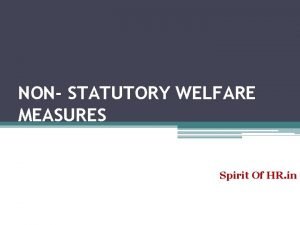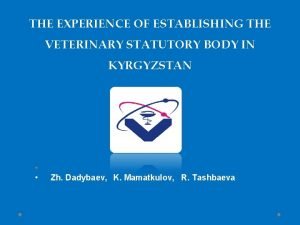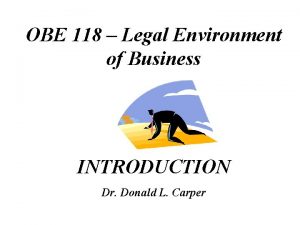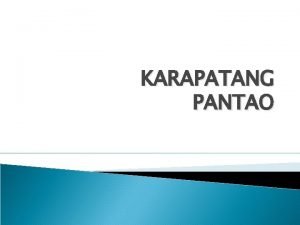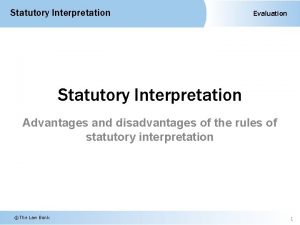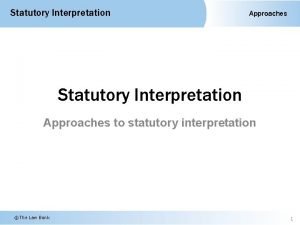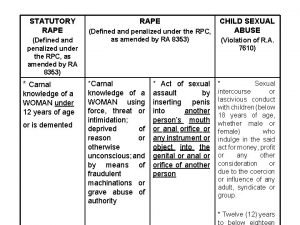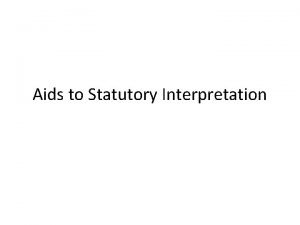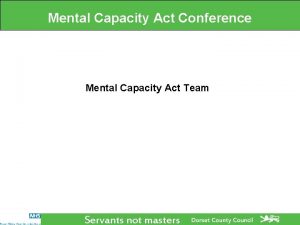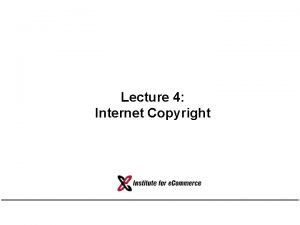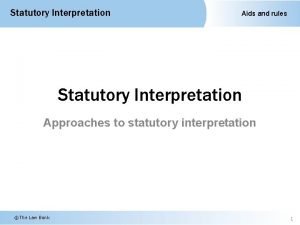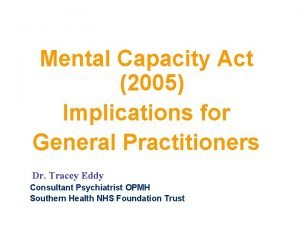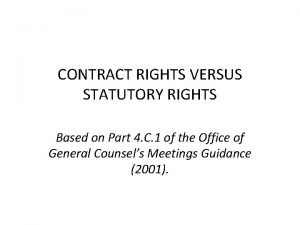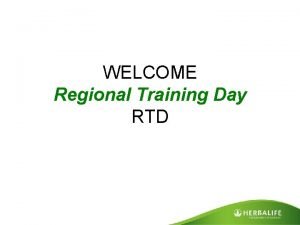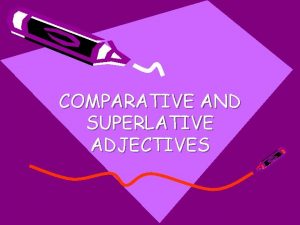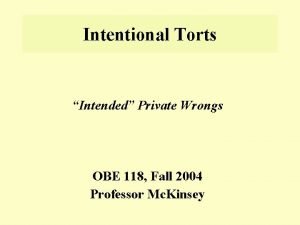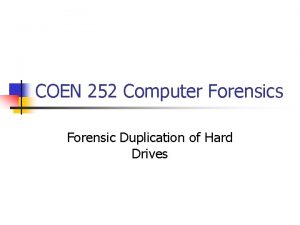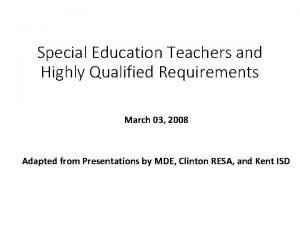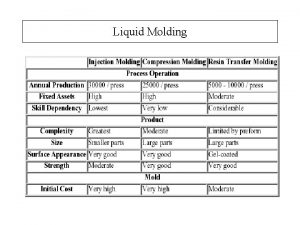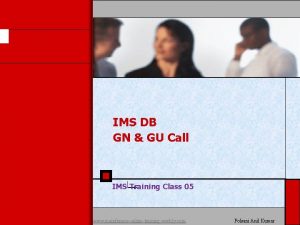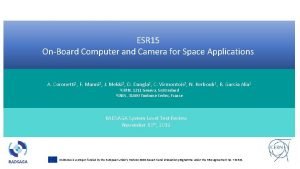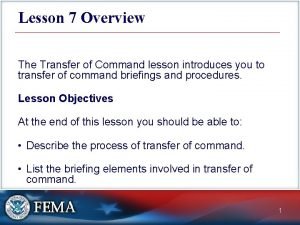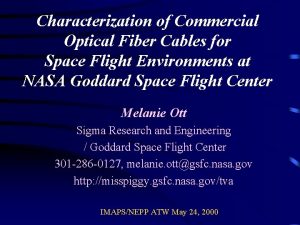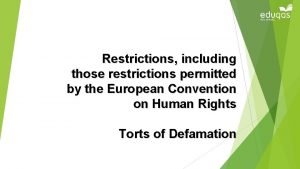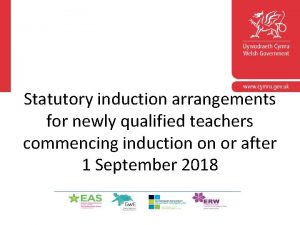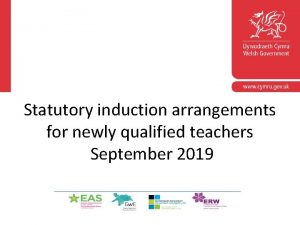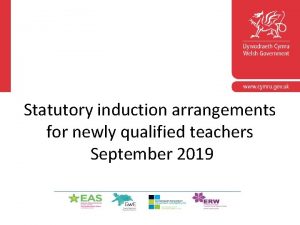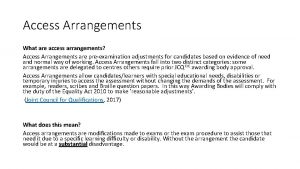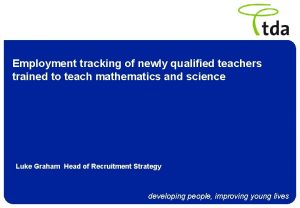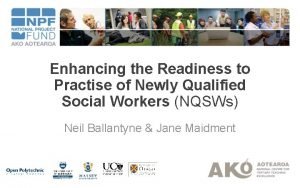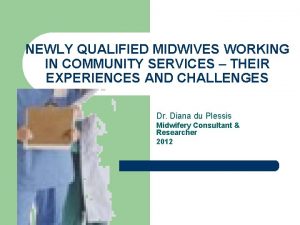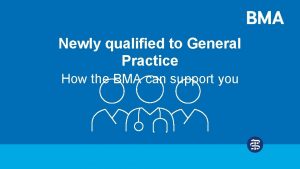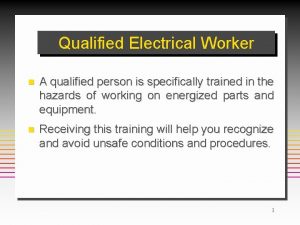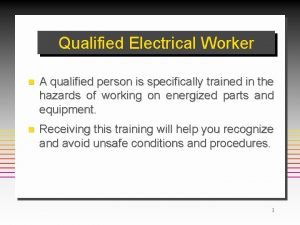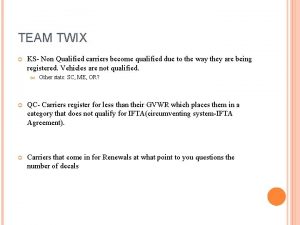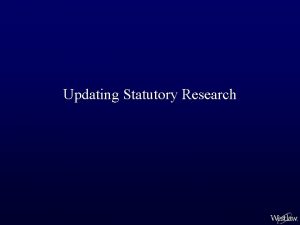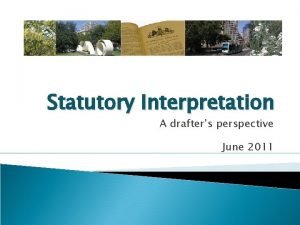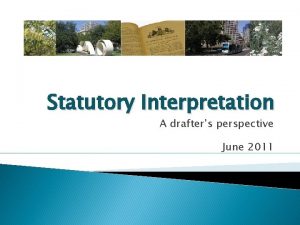Statutory induction arrangements for newly qualified teachers commencing















































- Slides: 47

Statutory induction arrangements for newly qualified teachers commencing induction on or after 1 September 2018

Topics covered • The statutory induction rationale, arrangements and process • New professional standards for teaching and leadership • Roles and responsibilities • The induction profile • Information regarding the LA / AB

Induction arrangements rationale • Consistency in structure and support • Flexibility within different patterns of employment • High quality experience for the NQT • Fair and equitable process • Rigorous and consistent assessment

The statutory induction arrangements • The arrangements for statutory induction for ALL NQTs in Wales is a collaborative process between the NQT, the induction mentor (IM), the external verifier (EV) and the Appropriate Body (AB) or the LA induction co-ordinator and regional consortia.

The induction period • All NQTs must complete an induction period of – Three complete terms for NQTs on a full time contract – 380 school sessions for NQTs employed on a part time or temporary contract – 380 school sessions for NQTs undertaking short term supply

Where can induction take place • Maintained schools in Wales • Non maintained special schools in Wales • Independent schools in Wales where – The curriculum for any primary learner meets NC requirements – The curriculum for learners at KS 3 or 4 includes all core and foundation subjects – An agreement has been reached prior to the start of the induction period between the school and the LA that they will act as the AB – FE institutions where the institution is able to provide an NQT with an appropriate post to enable them to undertake their induction

Institutions where induction cannot take place • pupil referral units • community or foundation special schools established in a hospital • independent schools that do not meet the criteria described in the Regulations • independent nursery schools (unless they are independent schools that meet the • criteria specified in the Regulations) and other early years settings (unless they are maintained nursery schools) • schools requiring special measures, as judged by Estyn. See further details in guidance.

• In Wales it is a legal requirement that all NQTs must hold QTS and be registered as a school teacher with the EWC in order to undertake induction. • Induction starts on your first day as a teacher. Every session must be recorded. • An induction period cannot start until the NQT holds QTS, all teachers must be registered with the EWC.

For further information about mentoring, contact the consortium: Central South Jendy. H. Hillier@cscjes. org. uk Matthew. Robbins@cscjes. org. uk Heather. jones@cscjes, org. uk EAS Amanda. passmore@sewaleseas. org. uk deb. woodward@sewaleseas. org. uk Gw. E ieuanjones@gwegogledd. cymru Eifion. roberts@denbighshire. gov. uk ERW sarah. perdue@erw. org. uk jen. malcolm@erw. org. uk

New professional standards for teaching and leadership • Designed to inspire, challenge and support every practitioner to be the best they can be • Provide a framework for reflection and development • Five key professional standards: pedagogy, collaboration, leadership, innovation and professional learning • Overarching values and dispositions • Descriptors exemplify the application of each standard

NQTs and the professional standards for teaching and leadership • NQTs are required to demonstrate sufficient competence against all induction descriptors. • Explore the new standards and descriptors at: http: //learning. gov. wales/resources/collectio ns/professional-standards? lang=en#collection 2


13

14

• Reflect and record using your professional learning passport (PLP) on the Education Workforce Council (EWC) website


Video - induction https: //www. youtube. com/watch? v= tlc. HUNK 3 CDE

Roles and responsibilities overview Effective induction is achieved through a partnership between a number of key people, including the NQT, the school, the induction mentor, the external verifier and the Appropriate Body officer.

See Annex A guidance – Induction for newly qualified teachers in Wales


The NQTs should take responsibility for their own professional learning and demonstrate how their practice meets the professional standards. They must: • Inform their headteacher/supply agency they are a NQT • ensure they use the professional standards and the PLP to regularly reflect on their practice and capture experiences for mapping against the standards using their induction profile

• Record a range of professional learning experiences • Identify development priorities • Log all their sessions with the EWC • Inform the EWC if they move schools during their induction period or if their contract changes

The headteacher and school The headteacher and the school as a whole ensure that there is day-to-day support available to the NQT throughout the induction period as part of the school's overall mentoring arrangements.

The IM The induction mentor IM provides day-to-day support to the NQT and works with the EV to ensure the NQTs receive high quality mentoring and supervision and to provide a recommendation to the AB.

The EV quality assures the induction arrangements on behalf of the AB.

The AB has overall responsibility to ensure that induction meets the statutory requirements and uses assessment evidence to make the final decision on the induction outcome.

The employment or supply agency • Supply agencies must provide the necessary support to their NQTs and ensure that safeguarding and pre-employment checks are undertaken.

The EWC is your professional body. They provide access to the PLP and provide technical support. See Annex A guidance – Induction for newly qualified teachers in Wales

EWC Code of Conduct

The Welsh Government sets regulations and policy and specifies national priorities for professional learning.

The induction profile • The induction profile is the NQT’s online record of progress and achievement in meeting the requirements to successfully complete induction. • The induction profile will form the basis of the professional dialogue between the NQT and the IM and the external verifier. • Access the induction profile via www. ewc. wales

Completing the induction profile • Responsibility of the NQT • Collaborative process involving the induction mentor and the NQT, it may also involve evidence from the external verifier • NQT will work with the induction mentor to agree and plan priorities • NQTs on short term supply contracts will work with the external verifier to agree and plan priorities

Using the standards…with NQTs q each NQT to document professional learning experiences on their profile / PLP/Pebble Pad/ Pebble Pocket App q Regular professional conversations which feed into termly progress report. q over the course of a year, record examples of things like… § § § most successful examples of teaching a well organised educational visit a display or activity that stimulates further learning a useful contribution to a staff meeting involvement in an extended curriculum development group sensitively handling a delicate matter with a parent/carer developing a ‘new’ facet of teaching suggesting a change to a school policy links with community engaging with research application and impact of professional learning Waters (2018)

Using the standards…with NQTs q each NQT to document professional learning experiences on their profile / PLP/Pebble Pad/ Pebble Pocket App q Regular professional conversations which feed into termly progress report. q over the course of a year, record examples of things like… § § § t c e lf e R most successful examples of teaching a well organised educational visit a display or activity that stimulates further learning a useful contribution to a staff meeting involvement in an extended curriculum development group sensitively handling a delicate matter with a parent/carer developing a ‘new’ facet of teaching suggesting a change to a school policy links with community engaging with research application and impact of professional learning Waters (2018)

Guide to logging Experiences

Expected practice for Induction Mentors Ø fix a dedicated, regular time to meet with the NQT Ø conduct a range of monitoring activates e. g. lesson obs, book look, listening to learners, learning walk, planning documentation. Ø ensure all monitoring processes are uploaded via ‘view feedback button’ Ø pre determined discussion points based on e. g. career entry profile, targets, PLEs, lesson observations, book scrutiny, Ø questions to consider … § how do you know? § what is the impact? § are the 5 standards in balance? . . . why not? § how do we spread the good things? § who could you help? § how can we help you? § …ambitions for next time? 36

Coffee!!

• Work in groups of 3 or 4 • List the behaviours and skills IMs need to be effective mentors

Coaching and mentoring? Mentoring involves …… Mae mentora yn cynnwys …… • Nodi nodau dysgu ac ategu dilyniant • Identifying learning goals and supporting progression • Datblygu a chynyddu rheolaeth dysgwyr dros eu dysgu • Developing and increasing learners’ control over their learning • Gwrando’n astud • Active listening • Arsylwi, mynegi a thrafod arfer er mwyn gwella ymwybyddiaeth • Observing, articulating, and discussing practice to raise awareness • Dysgu a rennir • Shared learning • Rhoi arweiniad, adborth a lle y bo angen, cyfarwyddyd • Providing guidance, feedback and when necessary direction • Asesu, arfarnu ac achredu arfer • Assessing, appraising and accrediting practice 39

Mentoring and coaching continuum Continwwm mentora a hyfforddi Education Scotland www. educationscotland. gov. uk 40

Induction Mentor and External Verifier Schedule First half term Second half term Third half term Fourth half term Fifth half term Final half term Session 1 - 70 Session 71 -140 Session 141 - 210 Session 211 - 270 Session 271 - 330 Session 331 - 380 It is imperative that NQT’s are registered Dialogue with IM. NQT to begin to reflect on Continued dialogue with IM and reflection with the EWC. the Standards through PLE’s. against the Professional Standards for Teaching and Leadership. Record as PLE’s. Sessions Log in and familiarise with Pebble Pad. EV Introductory Visit Work towards Development Priorities. Timetable of EV observations and QA IM monitoring and observation as agreed. Complete Step 1 - Upload CEP and complete Induction Self- Assessment. Reviews for the academic year to be arranged. An Induction Mentor (IM) will be allocated. Discussion of Professional Standards for Meet with IM at or before 140 sessions for Review as agreed (see sessions 71 -140). First Progress Review. IM will set Development Priorities. A Cause for Concern will be raised if there Development priorities will be set (Step 2). NQT to complete response to progress are insufficient evidence of PLE’s or concerns over progress. reports (Step 2) Activity Possible EV lesson observation/QA Teaching and Leadership; Professional Learning Experiences (PLEs). Timetable for monitoring, observation and review to be discussed. A Cause for Concern will be raised if there is EV to be allocated on completion of 50 no evidence of PLE’s being recorded or concerns over progress. sessions. NQT comments to be added. NQT to begin to reflect on the Standards through PLE’s. Continued dialogue with IM and reflection against the Professional Standards for Teaching and Leadership. Record as PLE’s. Work towards Development priorities IM monitoring and observation as agreed. Possible EV lesson observation/QA Review as agreed (see sessions 71 -140). A Cause for Concern will be raised if there are insufficient evidence of PLE’s or concerns over progress. Meet with IM at or before 270 sessions for Second Progress Review. IM will set Development Priorities. NQT to complete response to progress reports (Step 2) NQT comments to be added. Continued dialogue with IM and reflection against the Professional Standards for Teaching and Leadership. Record as PLE’s. Work towards Development priorities Work towards IM monitoring and observation as Development Priorities. agreed. IM monitoring and Possible EV lesson observation/QA observation as agreed. Review as agreed (see sessions 71140). Possible EV lesson observation/QA Review as agreed (see sessions 71 -140). A Cause for Concern will be raised A Cause for Concern will Meet with IM at or before 380 be raised if there are insufficient evidence of PLE’s or concerns over progress. sessions. if there are insufficient evidence of PLE’s or concerns over progress. NQT submits profile on completion at 380 sessions IM and EV will complete Review and Recommendation. Short Term Supply (STS) NQT’s. Please note: It is imperative that you register with the EWV as a Short Term Supply Teacher. You need to log your sessions after every 15 days worked. EVERY SESSION COUNTS. Print off the Record of attendance for Short Term Supply NQT’s only. This needs to be signed by the HT/DHT of every school you undertake supply in (keep as a running record) and uploaded to your Pebble Pad at regular intervals. You will be allocated an External Verifier (EV) on completion of 50 sessions. Your EV will also take on the role of Internal Mentor (IM) and complete all required observations, development meetings, reviews and documentation.

Short term supply • Be aware of short Term Supply (STS) NQTs working in your school. • Short Term Supply (STS) should also receive mentoring on a day-to-day basis.

What is the NQT entitled to? 10% non contact time in addition to PPA. Access to an induction mentor. * Allocated an External Verifier. * Ensuring NQT has access to a range of professional development opportunities. • Appropriate day to day support. • • *For short term supply the EV will undertake the role of both IM and EV.

Difference between EV and IM • quality assure the induction arrangements in schools on behalf of ABs to ensure NQTs are able to use the standards effectively • See appendix A for more details

Cause for concern and action plan • If the IM or the EV has any concerns about a NQT’s progress, they must raise them with the NQT and the AB immediately. • An action plan is put in place which is agreed by the NQT, the school and the EV. This is uploaded to profile.

Cause for concern and action plan • The AB should write to the NQT about the requirements for assessment and the consequences of failing to make the necessary improvement. A copy of the written notification should be held by the NQT’s school(s) and the EV.

FAQ - IM • How many pieces of evidence? • What is a good professional learning experience? • Is there a certain number of observations? • If I have a short term supply when do I have to inform the EWC? • What is the funding? • What form do I need for a lesson observation? • How many times do I need to observe? • When can I apply for an extension? • What is an acceptable asset? How do we ensure assets are GDPR compliant?
 Induction for newly qualified teachers
Induction for newly qualified teachers Statutory and non statutory welfare measures
Statutory and non statutory welfare measures Week commencing today
Week commencing today Kim kroll teachers pay teachers
Kim kroll teachers pay teachers Rights of hire purchase
Rights of hire purchase Statutory interpretation exam questions
Statutory interpretation exam questions Veterinary statutory body
Veterinary statutory body Non statutory subjects national curriculum
Non statutory subjects national curriculum Statutory law
Statutory law Statutory rse
Statutory rse Halimbawa ng paglabag sa karapatang pantao
Halimbawa ng paglabag sa karapatang pantao Advantages and disadvantages of the golden rule
Advantages and disadvantages of the golden rule R v allen (1872)
R v allen (1872) Statutory rape rpc
Statutory rape rpc Non banking statutory financial organization
Non banking statutory financial organization Extrinsic and intrinsic aids to statutory interpretation
Extrinsic and intrinsic aids to statutory interpretation Statutory principles of the mca
Statutory principles of the mca Statutory interpretation outline
Statutory interpretation outline Powell v kempton park racecourse
Powell v kempton park racecourse Muir v keay
Muir v keay Meeting adjournment
Meeting adjournment Independent maori statutory board
Independent maori statutory board Statutory fund cooperative
Statutory fund cooperative Statutory principles of the mca
Statutory principles of the mca Statutory rights example
Statutory rights example Statutory bonus
Statutory bonus Statutory relationship
Statutory relationship What is the nec definition of a qualified person
What is the nec definition of a qualified person Herbalife 35% discount price list
Herbalife 35% discount price list Comparative and superlative rules
Comparative and superlative rules Testimonial evidence examples
Testimonial evidence examples Herbalife qualified producer
Herbalife qualified producer Herbalife unencumbered volume points
Herbalife unencumbered volume points Voluntary qualified importer program
Voluntary qualified importer program Qualified privilege
Qualified privilege Tab team herbalife
Tab team herbalife Qualified forensic duplicate
Qualified forensic duplicate Highly qualified special education teacher
Highly qualified special education teacher Pri eaudit
Pri eaudit Ref-qualified member functions
Ref-qualified member functions Sqrtm - same-qualified resin transfer moulding
Sqrtm - same-qualified resin transfer moulding Cbltdli
Cbltdli Space qualified camera
Space qualified camera When command is transferred the process
When command is transferred the process Space qualified fiber optic cable
Space qualified fiber optic cable Qualified privilege
Qualified privilege 7 steps to becoming a qualified artisan
7 steps to becoming a qualified artisan Downline herbalife
Downline herbalife

